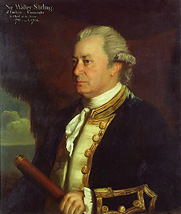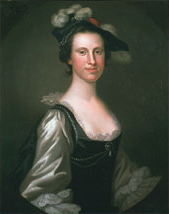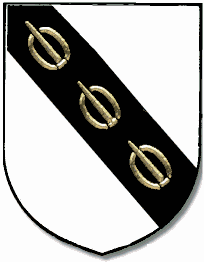
Captain Sir Walter Stirling of Faskine
Captain Sir Walter Stirling of Faskine was born May 7, 1718 in Sherva, Fife, Scotland, and died November 24, 1786 in Red Lion Square, London.
 Sir Walter Stirling of Faskine went to sea at an early age. . . . He entered the Navy, and was promoted to the rank of lieutenant in 1745. In 1753-4 he was engaged in commerce, trading to Philadelphia [where, on October 31, 1753, he married Dorothy Willing, born August 3, 1735, daughter of Charles Willing and Anne Shippen.] . . . In 1757 he was appointed to the command of a sloop of war; in 1759 he was promoted to the rank of post captain and given the command of the Lynn, a 40-gun ship; in 1761 he was given command of the Lowestoffe. His first command after peace was in 1763, when he was given the Rainbow, of 40 guns, and ordered to the North American Station, where he continued till 1766. In 1770 he was appointed to the Dunkirk, of 60 guns, the flagship of Commodore Mackenzie, senior officer on the Jamaica Station. In 1778 he was appointed a regulating captain on the impress service. In 1780 he was given command of the Gilbraltar, of 80 guns, one of the squadron sent to the West Indies, under the orders of Sir Samuel Hood to reinforce Lord Rodney. The expedition against the Dutch Island of St. Eustatia, taking place soon after his arrival on that station, he was chosen to be the welcome messenger of the Success, and in consequence he received the honour of knighthood. In 1781 he was appointed to the command at the Nore, and hoisted his broad pennant, as Commodore, on board the Coquestador, removing afterwards to the Prince Edward, of 60 guns. He left this command before the end of 1782, and in the same year was appointed to the Duke, of 80 guns, under Admiral Kempenfelf. [Also in 1782, his wife died on September 20 in Drumpellier, Lanarkshire, Scotland. – ENF] Soon after, in action with the French, with an inferior force, they captured many transports full of troops bound for India.
Sir Walter Stirling of Faskine went to sea at an early age. . . . He entered the Navy, and was promoted to the rank of lieutenant in 1745. In 1753-4 he was engaged in commerce, trading to Philadelphia [where, on October 31, 1753, he married Dorothy Willing, born August 3, 1735, daughter of Charles Willing and Anne Shippen.] . . . In 1757 he was appointed to the command of a sloop of war; in 1759 he was promoted to the rank of post captain and given the command of the Lynn, a 40-gun ship; in 1761 he was given command of the Lowestoffe. His first command after peace was in 1763, when he was given the Rainbow, of 40 guns, and ordered to the North American Station, where he continued till 1766. In 1770 he was appointed to the Dunkirk, of 60 guns, the flagship of Commodore Mackenzie, senior officer on the Jamaica Station. In 1778 he was appointed a regulating captain on the impress service. In 1780 he was given command of the Gilbraltar, of 80 guns, one of the squadron sent to the West Indies, under the orders of Sir Samuel Hood to reinforce Lord Rodney. The expedition against the Dutch Island of St. Eustatia, taking place soon after his arrival on that station, he was chosen to be the welcome messenger of the Success, and in consequence he received the honour of knighthood. In 1781 he was appointed to the command at the Nore, and hoisted his broad pennant, as Commodore, on board the Coquestador, removing afterwards to the Prince Edward, of 60 guns. He left this command before the end of 1782, and in the same year was appointed to the Duke, of 80 guns, under Admiral Kempenfelf. [Also in 1782, his wife died on September 20 in Drumpellier, Lanarkshire, Scotland. – ENF] Soon after, in action with the French, with an inferior force, they captured many transports full of troops bound for India.

Dorothy Willing 1735-1782
Excerpt from: Thomas Willing Stirling, The Stirlings of Cadder, published 1933
Charles Willing 1710-1754
Sir Walter Stirling had been a dashing naval officer who had wooed and won the daughter of a wealthy Philadelphian merchant, Charles Willing. Somewhat against the family’s wishes he brought his Dorothea back to live in London, where she charmed his peers. He had a distinguished career, having been made “The Regulating Captain of the Impress at the Tower,” knighted for naval pursuits against the Dutch and then appointed Commander-in-Chief at Nore. [Dorothy’s daughter] liked to tell the story of how her father had lost the chance to be Governor of Halifax because he had been visiting her in Scotland when the offer came in. Her young sons [i.e. Walter and Dorothy’s grandsons], however, were more impressed with the story of how Grandfather had persuaded the reluctant Nelson family to allow young Horatio to enter the navy.
It was a matter of pride that King George III, after reviewing Sir Walter’s ships at the Nore, was so impressed that he had offered to make him a baronet – which he declined.
Excerpt from: Pamela Statham-Drew, James Stirling Admiral and Founding Governor of Western Australia
Biography published in 2003 by the University of Western Australia Press
Sir Walter was father of Vice-Admiral Sir Charles Stirling and grandfather of Sir James Stirling
Description of the painting of Walter
Artist James Northcote; National Maritime Museum, London
A half-length portrait in captain’s, over three years, full-dress uniform, 1774-87. The sitter wears his own hair, powdered a scratch wig and holds a telescope in his left hand. At an advanced age, in 1780, he was Captain of the Gibraltar, 80 guns, under Sir Samuel Hood and was present at Rodney’s capture of St Eustatius in the West Indies from the Dutch in 1781. He was selected to take home dispatches and was knighted on arrival. In 1782, he was Commodore at the Nore. The background consists of rock with a glimpse of the sea on the left. The portrait is inscribed “Sir Walter Stirling of Faskine, Commander-in-Chief at the Nore 1781-d.1786”. The artist was a pupil and assistant of Reynolds, and practiced portraiture at Plymouth until 1777, when he went to Italy to study before settling in London in 1781. The artist’s signature is unseen.
Description of the Painting of Dorothy
John Wollaston, Dorothy Willing (Mrs. Walter Stirling), about 1752.
More information about the pictures of Dorothy and Charles may be found at: http://www.worcesterart.org/Collection/Early_American/Artists/wollaston/C_Willing/discussion.html
Biography kindly submitted by Elspeth Flood
